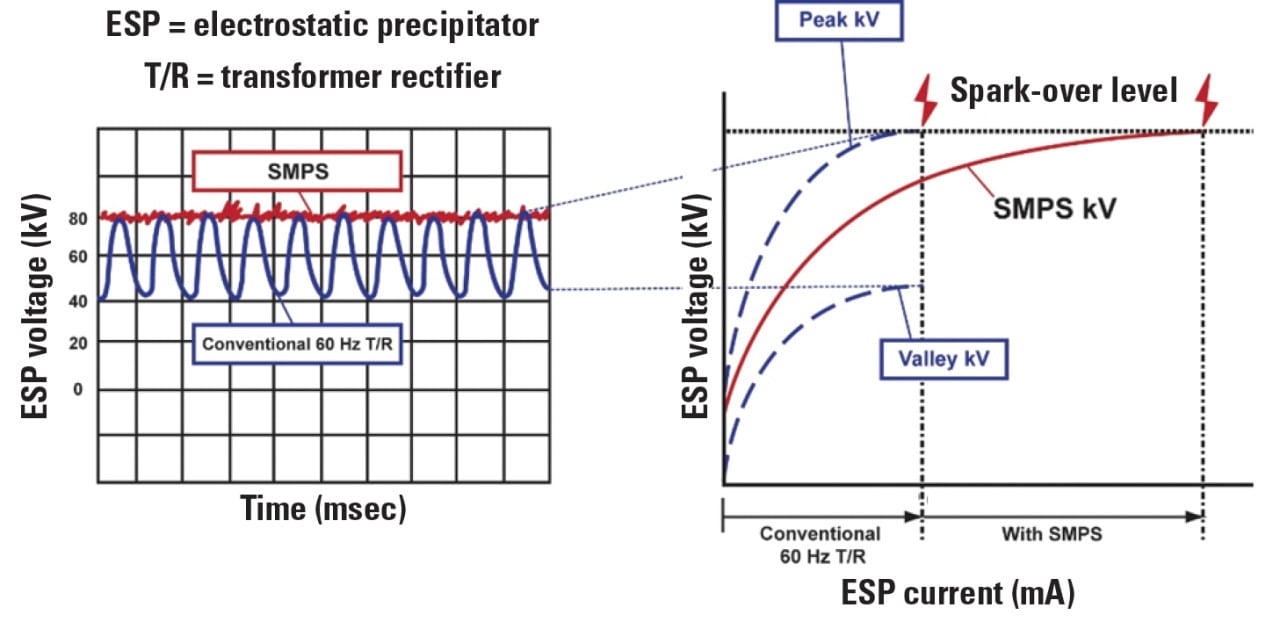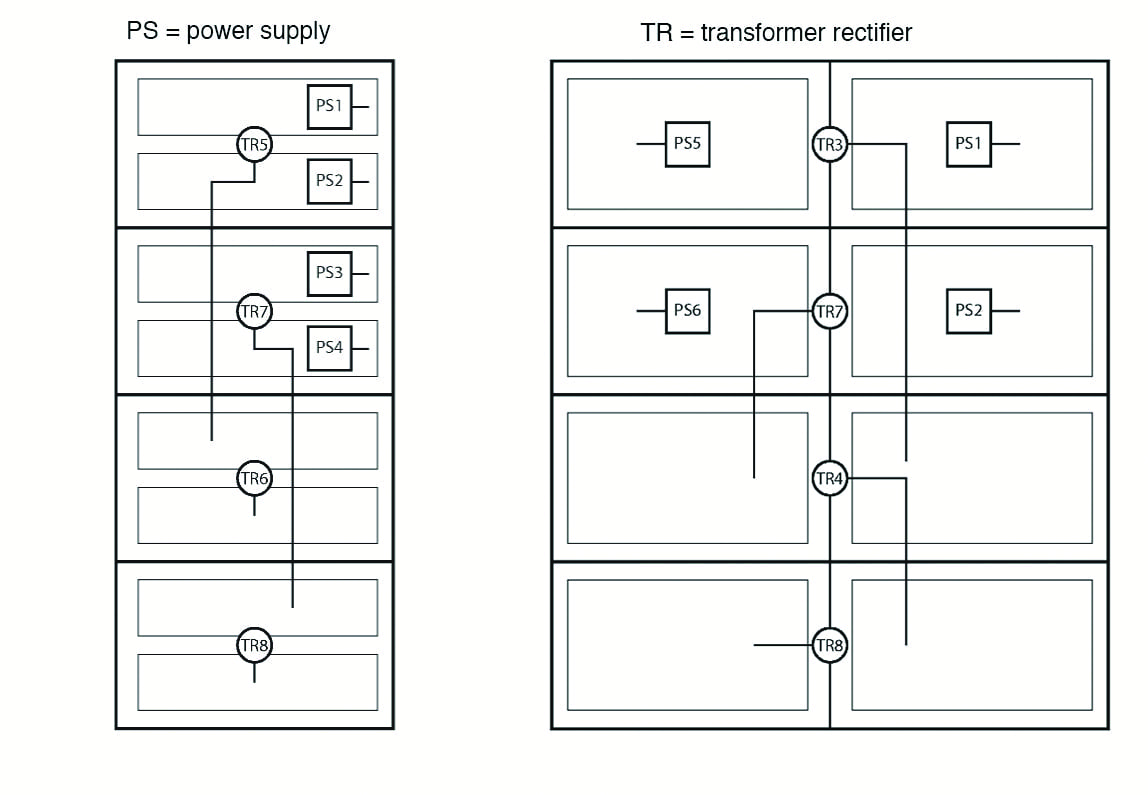Retrofitting Electrostatic Precipitators to Meet Current Emission Limits
Electrostatic precipitators (ESPs) offer a tried-and-true technology for particulate matter control. However, existing ESPs can be challenged to meet the latest regulatory requirements. Retrofitting power supplies and other equipment offers the potential for improved ESP performance.
The U.S. Environmental Protection Agency’s Mercury and Air Toxics Standards (MATS) rule, which became effective in April 2015, provides emission limits for filterable particulate matter (PM) and other hazardous air pollutants, such as mercury, acid gases, trace metals, and organics, from coal-fired power plants. Under the MATS rule, the maximum achievable control technology total particulate emissions limit is 0.03 lb/MMBtu for existing coal-fired plants.
To meet these emissions limits for control of PM, one of the most-reliable and often-utilized control technologies is an electrostatic precipitator (ESP), which is a well-established and mature technology. However, as regulatory requirements have become increasingly more stringent, many existing precipitators are being challenged to collect PM beyond their original design specifications.
For example, some plants may now use dry sorbent injection for acid gas control and activated carbon injection for mercury control, with the expectation that the existing ESP will remove the PM. In some instances, depending on ESP size and condition, the ESP may no longer operate as efficiently under these conditions.
Few, if any, new precipitators are currently being built and installed in today’s U.S. coal-fired marketplace. As a result, plants that are seeking to meet the new limits, and that have sufficiently sized ESPs in good mechanical and working condition, are aiming to enhance performance of their existing ESPs through upgrades or rebuilds of the ESPs with newer power supplies. Modern-day power supplies that deliver higher average and peak voltage operation provide a viable means of boosting the operating performance of an existing precipitator.
Over the past several years, the Electric Power Research Institute (EPRI) has conducted a number of studies on the effectiveness of retrofit options for ESPs to meet new environmental regulations. The most recent study surveyed power supply technology advancements, such as high-frequency power supplies (HFPSs) and new three-phase low- and mid-frequency power supplies. The study also documented case studies of ESP retrofits at five different plants. The study and its findings are described in an EPRI report, ESP Upgrades and Optimization: Operating Under MATS Conditions (3002006099).
ESP Power Supplies
When a plant is considering re-powering an existing precipitator to meet an emissions goal, the plant owners should first undertake a full evaluation of the precipitator and plant operating conditions to assess whether the re-powered precipitator could reasonably be expected to meet the goal and to determine what additional steps, if any, might also have to be taken to attain that goal. Additional steps might include mechanical repairs, gas and particulate flow modifications, additional electrical sectionalization, rapper sequence modifications, and flue gas conditioning.
If the ESP is found to be in good mechanical order, and operating near the desired emissions level, then replacement of the power supply may provide the best means of ensuring its performance.
Precipitator performance is directly related to the operating voltages in the system, and the power supply is the key system component providing the high-voltage (HV) direct current (DC) power (voltage and current) directly to the discharge electrodes needed for electrostatic precipitation.
Historical Development of ESP Power Supplies
Throughout the developmental history of ESPs, their design and performance have been limited by the rating and design of the power supplies. As the power supply and circuit component design improved and higher voltages were achievable, ESP designs evolved to utilize the high voltages and currents by increasing the collecting plate-to-discharge electrode spacing, increasing the total collecting area connected to one power supply, and modifying the discharge electrode geometry.
The earliest power supplies used a step-up transformer to generate high voltage with a separate rectifier component. Mechanical rectification was the first option available for converting alternating current to DC. Mechanical rectifiers function through the use of multiple switches that are opened and closed to alter the electric path of the electric current.
Vacuum tube rectifiers, introduced in the 1950s, were a breakthrough that permitted DC electrostatic precipitation to become more practical. The tubes were fairly large because of the high voltages needed and were typically glass enclosures. The tube rectifiers offered a quantum improvement in reliability and practicality over mechanical rectifiers. The disadvantages of tube rectifiers, as compared to solid-state rectification, are the relatively high cost, limited life cycle, and excessive heat created by the filament.
Transformer rectifiers (TRs), using silicon diodes for rectification of the HV output of the step-up transformer, were first used in the 1960s and have been the standard for many years. The HV transformer and rectifier components are housed together in a single dielectric oil-filled tank that is sealed and suitable for outside use. The TRs are of robust design and are manufactured specifically for the conditions unique to the ESP application. The power supplies are designed to operate with an incoming voltage ranging from 400 V to 600 V, single phase, at either 50 Hz or 60 Hz.
High-Frequency Power Supplies
At present, the most commonly used power supply in ESP retrofits and upgrades are HFPSs. Unlike conventional single-phase TRs that operate at 60 Hz, three-phase HFPSs operate at considerably higher frequency levels—up to 35 kHz. These power supplies became available around 1994 and are typically referred to as switched-mode power supplies (SMPSs) or HFPSs.
The main components allowing the power to be switched at high frequency are insulated-gate bipolar transistors (IGBTs), which have been improved over the past two decades to allow high power levels to be achieved and to improve reliability. These power supplies operate at approximately the same peak kV levels as the conventional TRs they replace, but due to the higher frequency, they maintain average kV levels that are significantly higher than the average kV levels attained with a conventional single-phase, 60-Hz power supply.
The change from a single-phase circuit to a three-phase circuit provides better balance for the electrical load, and this tends to result in power factor improvement. For instance, the same input power into the SMPS can deliver 20% to 30% more output power than a conventional single-phase TR and power savings can be realized. The high-frequency operation also results in quicker response time to circuit disruption (sparking). The result is more power applied to the precipitator field (Figure 1).
HFPSs integrate all the main circuit components, including the transformer, rectifier, and controller, into a single, compact unit that is comparatively lightweight. Their operation also offers greater control flexibility.
The reliability of the HFPSs is now nearly on par with the conventional 60-Hz TR and circuit components. However, this was not always the case. When they were first introduced, and as they grew in size capacity, problems occurred related to power quality, harmonics, and voltage transients on the power lines; high-voltage transients due to sparking/arcing and poor grounding; inadequate cooling, leading to overheating; and high-temperature failures. These problems tended to be site and installation specific. They have been largely overcome, and HFPSs are now well-accepted as a reliable product for increasing precipitator power.
New Technologies: Three-Phase Low- and Mid-Frequency Power Supplies
A number of other technologies have been introduced in the past few years and are being used in ESP retrofits. These technologies include three-phase TRs and controls operating at 180 Hz, and mid-frequency TRs and controls that operate in the 100-Hz to 400-Hz range. Like the HFPS, the goal of these power supplies is to increase the average kV closer to the peak kV in the ESP to improve power. Also, like the HFPS, the mid-frequency power supplies rely on use of IGBT switch technology.
While the voltage ripple reduction and performance enhancement capabilities of these lower-frequency power supplies are not comparable to that of HFPSs, they are still able to attain significant ripple reduction with the design intent of avoiding the complexity of HFPSs and preserving the proven reliability associated with the conventional single-phase, 60-Hz power supply.
These new technologies are not integrated like HFPSs. They comprise a separate TR, a separate control cabinet, a switch assembly that is usually housed in the control cabinet, and a current-limiting reactor that may be located in the TR set, the control cabinet, or in a separate enclosure. These power supplies offer greater compatibility with existing ESP equipment, such as voltage controls, rapper controls, and supervisory controls. Cost, availability, and predicted reliability may make these power supplies more attractive than HFPSs.
Case Studies
The most recent EPRI study documented five case studies of plants retrofitting their ESPs. The plants involved were of the following designs:
■ Two 1,200-MW units with one-third of the ESP sectionalized and retrofitted with a HFPS.
■ Two 423-MW units retrofitted 100% with HFPS.
■ One 550-MW unit retrofitted 100% with HFPS.
■ One 550 MW unit retrofitted 100% with HFPS.
■ One 112-MW unit sectionalized and retrofitted with a three-phase low-frequency power supply.
Some of these case studies also involved increased electrical sectionalization, which enhances the collection efficiency of the various fields across and through the ESP (Figure 2). The case studies are summarized in Table 1.
Potentially Improved ESP Performance
All of the new power supplies (HFPS, three-phase low- and mid-frequency) and other equipment described in the EPRI report offer the potential for improved ESP performance and should be considered when an existing precipitator is in need of a performance upgrade or the existing conventional TR sets are in need of replacement.
Voltage-current curves generated from ESP operating data (secondary voltage versus secondary current) and computer modeling can be used to predict potential performance enhancement and the best new power supply configuration. Exact performance will depend on the size of the ESP, the fuel quality, and consequently its particulate properties. Process conditions, including the application of sorbents for environmental control, flue gas and particulate distribution, and other site-specific conditions, will affect results.
The new power supplies are not a panacea for an ESP that is in poor mechanical condition, but for precipitators that are in reasonably good mechanical condition, they offer a viable means for performance enhancement. For some ESPs, they can be the difference between a marginally compliant ESP and a reliably compliant ESP at substantially less cost than adding collecting surface area or a polishing unit. ■
—Jose Sanchez ([email protected]) is technical leader for the Integrated Environmental Controls Program in EPRI’s Generation Sector, and Tom Keeler ([email protected]) is president of TRK Engineering Services, which specializes in ESPs.


